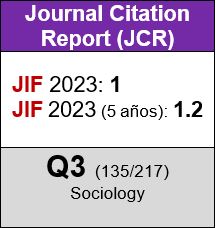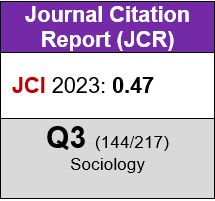La experiencia del trabajo a distancia durante el confinamiento en Cataluña: una aproximación desde la perspectiva de género
DOI:
https://doi.org/10.5477/cis/reis.183.77Palabras clave:
Categoría laboral, Ciclo vital, Corresponsabilidad, Género, Teletrabajo, Trabajo doméstico, Uso del tiempoResumen
El objetivo de este artículo es contribuir al debate sobre el impacto de género del teletrabajo, tomando como caso de estudio el confinamiento domiciliario de la población catalana durante los primeros meses de la pandemia de COVID-19. En concreto, se analizan las experiencias y valoraciones acerca del trabajo a distancia de hombres y mujeres a partir de la Encuesta sobre Uso del Tiempo y Confinamiento realizada por el Centre Estudis Opinió. Los resultados indican que la experiencia del trabajo a distancia, lejos de favorecer la corresponsabilidad en el trabajo doméstico y de cuidados, refuerza la brecha de género en el trabajo reproductivo.
Descargas
Citas
Actis di Pasquale, Eugenia; Iglesias-Onofrio, Marcela; Pérez de Guzmán, Sofía y Viego, Valentina (2021).
«Teletrabajo, vida cotidiana y desigualdades de género en Iberoamérica». Revista Economía Crí- tica, 1(31): 44-61.
Aguado, Empar y Benlloch, Cristina (2020). «Teletra- bajo y conciliación: el estrés se ceba con las mu- jeres». The Conversation. Disponible en: https:// theconversation.com/teletrabajo-y-conciliacion- el-estres-se-ceba-con-las-mujeres-137023, ac- ceso 15 de noviembre de 2021.
Alon, Titan; Doepke, Matthias; Olmstead-Rumsey, Jane y Tertilt, Michele (2020). «The Impact of COVID-19 on Gender Equality». [Working paper series N.º 26947]. National Bureau of Economic Research. doi: 10.3386/w26947
Bae, Kwang Bin y Kim, Dohyeong (2016). «The Impact of Decoupling of Telework on Job Satisfaction in
U.S. Federal Agencies: Does Gender Matter?». The American Review of Public Administration, 46(3): 356-371. doi: 10.1177/0275074016637183 DOI: https://doi.org/10.1177/0275074016637183
Beauregard, T. Alexandra y Basile, Kelly (2016).
«Strategies for Successful Telework: How Ef- fective Employees Manage Work/Home Bound- aries». Strategic HR Review, 15(3): 106-111. doi: 10.1108/SHR-03-2016-0024 DOI: https://doi.org/10.1108/SHR-03-2016-0024
Belzunegui-Eraso, Ángel (2002). Teletrabajo: Estra- tegias de flexibilidad. Madrid: Consejo Econó- mico y Social.
Beneria Farré, Lourdes (1981). «Reproducción, pro- ducción y división sexual del trabajo». Mientras- tanto, 6: 47-84.
Brines, Julie (1994). «Economic Dependency, Gen- der, and the Division of Labor at Home». Ameri- can Journal of Sociology, 100(3): 652-688. DOI: https://doi.org/10.1086/230577
CEO (2020a). Fitxa Tècnica Enquesta sobre els usos del temps i el confinament. Barcelona: Cen- tre Estudis Opinió. Disponible en: https://ceo. gencat.cat/ca/estudis/registre-estudis-dopi- nio/estudis-dopinio-ceo/societat/detall/index. html?id=7608, acceso 10 de julio de 2021.
CEO (2020b). Qüestionari Enquesta sobre usos del temps i el confinament. Barcelona: Centre Estu- dis Opinió. Disponible en: https://upceo.ceo.gen- cat.cat/wsceop/7608/Cuestionario%20-966.pdf, acceso 10 de julio de 2021.
Chung, Heejung y Horst, Mariska van der (2018). «Women’s Employment Patterns after Childbirth and the Perceived Access to and Use of Flexi- time and Teleworking». Human Relations, 71(1): 47-72. doi: 10.1177/0018726717713828 DOI: https://doi.org/10.1177/0018726717713828
Collins, Caitlyn; Landivar, Liana C.; Ruppanner, Leah y Scarborough, William. J. (2020). «COVID-19 and the Gender Gap in Work Hours». Gender, Work and Organization, 28(1): 101-112. doi: 10.1111/gwao. 12506 DOI: https://doi.org/10.1111/gwao.12506
Craig, Lyn y Churchill, Brendan (2020). «Dual-Earner Parent Couples' Work and Care during COVID-19». Gender, Work and Organization, 28(1): 66-79. doi: 10.1111/gwao.12497 DOI: https://doi.org/10.1111/gwao.12497
Eurofound (2017). Working Anytime, Anywhere: The Effects on the World of Work. Geneva: Publica- tions Office of the European Union, Luxembourg and the International Labour Office.
Eurofound (2020). Telework and ICT-Based Mobile Work: Flexible Working in the Digital Age, New Forms of Employment Series. Luxembourg: Pub- lications Office of the European Union.
Farré, Lídia y González, Libertad (2019). «Does Pa- ternity Leave Reduce Fertility?». Journal of Pub- lic Economics, 172: 52-66. doi: 10.1016/j.jpu- beco.2018.12.002 DOI: https://doi.org/10.1016/j.jpubeco.2018.12.002
Farré, Lidia; Fawaz, Yarine; González, Libertad y Graves, Jennifer (2020). How the COVID-19 Lockdown Affected Gender Inequality in Paid and Unpaid Work in Spain (No. 13434). IZA Discus- sion Papers. DOI: https://doi.org/10.2139/ssrn.3643198
Gálvez Mozo, Ana M.; Tirado, Francisco y Alcaraz, José M. (2020). «“Oh! Teleworking!” Regimes of Engagement and the Lived Experience of Female Spanish Teleworkers». Business Ethics: A European Review, 29(1): 180-192. doi: 10.1111/beer. 12240 DOI: https://doi.org/10.1111/beer.12240
Golden, Timothy D.; Veiga, John F. y Simsek, Zeki (2006). «Telecommuting’s Differential Im- pact on Work-family Conflict: Is There No Place like Home?». Journal of Applied Psychology,91(6):1340-1350. doi: 10.1037/0021-9010.91.6.1340 DOI: https://doi.org/10.1037/0021-9010.91.6.1340
González Ramos, Ana M. y García-de-Diego, José
M. (2022). «Work–Life Balance and Telework- ing: Lessons Learned during the Pandemic on Gender Role Transformation and Self-Re- ported Well-Being». International Journal Envi- ronmental Research Public Health, 19(14): 8468. doi: 10.3390/ ijerph19148468 DOI: https://doi.org/10.3390/ijerph19148468
Haddon, Leslie y Silverstone, Roger (1993). «Tele- working in the 1990s: A View from the Home». SPRU/ CICT, inform n.º 10, Falmer, Sussex: Uni- versidad de Sussex.
Hank, Karsten y Steinbach, Anja (2020). «The Virus Changed Everything, Didn't It? Couples' Division of Housework and Childcare Before and During the Corona Crisis». Journal of Family Research, 33(1): 99-114. doi: 10.20377/jfr-488 DOI: https://doi.org/10.20377/jfr-488
Hilbrecht, Margo; Shaw, Susan M.; Johnson, Laura
C. y Andrey, Jean (2008). «I'm Home for the Kids': Contradictory Implications for Work-life Balance of Teleworking Mothers». Gender, Work and Or- ganization, 15(5): 454-476. doi: 10.1111/j.1468- 0432.2008.00413.x DOI: https://doi.org/10.1111/j.1468-0432.2008.00413.x
Huws, Ursula; Podro, Sarah; Gunnarsson, Ewa; Weijers, Thea; Arvanitaki, Katerina y Trova, Vangelio (1996). Teleworking and Gender. Institute for Employment Studies, Report 317. DOI: https://doi.org/10.1016/S0024-6301(97)84588-8
Kelly, Erin. L; Moen, Phyllis; Oakes, J. Michael; Fan, Wen; Okechukwu, Cassandra; Davis, Kelly; Hammer, Leslie; Kossek, Ellen Ernest; King, Rosalind; Hanson, Ginger; Mierzwa, Frank y Casper, Lynne M. (2014). «Changing Work and Work-Family Conflict: Evidence from the Work, Family, and Health Network». American Socio- logical Review, 79(3): 485-516. doi: 0.1177/0003122414531435 DOI: https://doi.org/10.1177/0003122414531435
Madsen, Susan R. (2011). «The Benefits, Chal- lenges, and Implication of Teleworking: A Liter- ature Review». Journal of Culture and Religion, 1(1): 148-158.
Mayo, Margarita; Pastor, Juan C.; Cooper, Cary y Sanz-Vergel, Ana I. (2011). «Achieving Work-family Balance Among Spanish Managers and their Spouses: A Demands-control Perspective». The International Journal of Human Resource Manage- ment, 22(2): 331-350. doi: 10.1080/09585192.2011.540158 DOI: https://doi.org/10.1080/09585192.2011.540158
Mirchandani, Kiran (2000). «The Best of Both Worlds' y 'Cutting My Own Throat': Contradictory Images of Home-based Work». Qualitative Sociology, 23(2): 159-182. doi: 10.1023/A:1005448415689 DOI: https://doi.org/10.1023/A:1005448415689
Mooi-Reci, Irma y Risman, Barbara J. (2021). «The Gendered Impacts of COVID-19: Lessons and Reflections». Gender and Society, 35(2): 161-
doi: 10.1177/08912432211001305 DOI: https://doi.org/10.1177/08912432211001305
Moreno Colom, Sara y Borràs Català, Vicent (2021). Que teletrabajen ellos. Aprendizajes de la pandemia más allá de lo obvio. Barcelona: MRA Ediciones.
Ortiz-Lozano, José M.; Martínez-Morán, Pedro C. y Fernández-Muñoz, Iván (2021). «Difficulties for Teleworking of Public Employees in the Spanish Public Administration». Sustainability, 13: 8931. doi: 10.3390/su13168931 DOI: https://doi.org/10.3390/su13168931
Pearse, Rebecca y Connell, Raewyn (2016). «Gender Norms and the Economy: Insights From Social Research». Feminist Economics, 22(1): 30-53. doi: 10.1080/13545701.2015.1078485 DOI: https://doi.org/10.1080/13545701.2015.1078485
Pérez Sánchez, Carmen (2010). «El teletrabajo:
¿Más libertad o una nueva forma de esclavitud para los trabajadores?». Revista de Internet, De- recho y Política, 11: 24-32. Disponible en: https:// raco.cat/index.php/IDP/article/view/225853
Pérez Sánchez, Carmen y Gálvez Mozo, Ana M. (2009). «Teletrabajo y vida cotidiana: ventajas y dificultades para la conciliación de la vida laboral personal y familiar». Athenea Digital, 15: 57-79.
R Core Team (2020). R: A Language and Environ- ment for Statistical Computing. R Foundation for Statistical Computing. Vienna, Austria. Disponible en: https://www.R-project.org/, acceso 10 de ju- lio de 2021.
Salganik, Matthew (2017). Bit by Bit: Social Re- search in the Digital Age. Princeton, New Jersey: Princeton University Press. Open Review Edition.
Seiz Puyuelo, Marta (2021). «Equality in Confine- ment: Nonnormative Divisions of Labour in Span- ish Dual-Earner Families During the Covid-19 Lockdown». Feminist Economics, 27(1-2): 345-361. doi: 10.1080/13545701.2020.1829674 DOI: https://doi.org/10.1080/13545701.2020.1829674
Sevilla, Almudena y Smith, Sarah (2020). «Baby Steps: The Gender Division of Childcare during the COVID19 Pandemic». Discussion Paper Series IZA. doi: 10.1093/oxrep/graa027 DOI: https://doi.org/10.2139/ssrn.3614250
Sullivan, Cath (2003). «What's in a Name? Defini- tions y Conceptualizations of Teleworking and Work at Home». New Technology, Work and Em- ployment, 18(3): 158-165. doi: 10.1111/1468- 005X.00118 DOI: https://doi.org/10.1111/1468-005X.00118
Sullivan, Cath y Lewis, Suzan (2001). «Home-based Telework, Gender, and the Synchronization of Work and Family: Perspectives of Teleworkers and their Co-residents». Gender, Work and Organization, 8(2): 123-145. doi: 10.1111/1468-0432.00125 DOI: https://doi.org/10.1111/1468-0432.00125
Titan, Alon; Doepke, Matthias; Olmstead-Rumsey, Jane y Tertilt, Michèle (2020). «The Impact of Covid-19 on Gender Equality». Covid Econom- ics, Vetted and Real-Time Papers, The Centre for Economic Policy Research, 4: 62-85. DOI: https://doi.org/10.3386/w26947
West, Candace y Zimmerman, Don H. (1987). «Do- ing Gender». Gender and Society, 1(2): 125-151. doi: 10.1177/0891243287001002002 DOI: https://doi.org/10.1177/0891243287001002002
Descargas
Publicado
Cómo citar
Número
Sección
Licencia
Derechos de autor 2023 REIS. Revista Española de Investigaciones Sociológicas

Esta obra está bajo una licencia internacional Creative Commons Atribución-CompartirIgual 4.0.
Permite Compartir — copiar y redistribuir el material en cualquier medio o formato, Adaptar — remezclar, transformar y construir a partir del material para cualquier propósito, incluso comercialmente.








